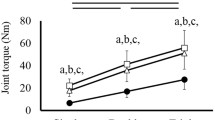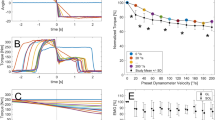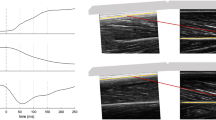Abstract
Muscle–tendon gearing is the ratio of the muscle–tendon unit velocity to the fascicle velocity and can be expressed as the product of the gearing within the muscle belly and the gearing due to tendon stretch. Previous studies have shown that gearing is variable and increases at higher velocities. Changes in the muscle activation levels and force development have been suggested to affect tendon gearing and thus muscle–tendon unit gearing. However, the role of belly gearing as a part of muscle–tendon gearing and its associations with structural aspects of muscle and thus movement performance are important facets that need to be studied. The two gastrocnemii of twenty young adults were tested during isokinetic and isotonic contractions on an ankle dynamometer. Ultrasound images of both muscles were collected during contractions and were later digitised. Gearing was also predicted using a 2-dimensional panel model of these muscles. The results from experimental and models tests showed increases in gearing with greater torque levels at slower contraction velocities. However, in the isotonic models there was a substantial increase in gearing at faster contraction velocities. The level of muscle–tendon unit gearing is largely determined by the belly gearing, but its variability is driven by changes in tendon gearing that in turn is a factor of the muscle activation and coordination. The belly thickness of the medial gastrocnemius decreased during contractions, but increased for the lateral gastrocnemius. It is likely that changes to the belly shape and 3-dimensional structure are important to the gearing of the muscle.






Similar content being viewed by others
References
Alexander RMcN (1969) The orientation of muscle fibres in the myomeres of fishes. J Mar Biol Assess UK 49:263–290
Aratow M, Ballard RE, Crenshaw AG, Styf J, Watenpaugh DE, Kahan NJ, Hargens AR (1993) Intramuscular pressure and electromyography as indexes of force during isokinetic exercise. J Appl Physiol 74:2634–2640
Azizi E, Gillis GB, Brainerd EL (2002) Morphology and mechanics of myosepta in a swimming salamander Siren lacertina. Comp Biochem Physiol A 133:967–978
Azizi E, Brainerd EL, Roberts TJ (2008) Variable gearing in pennate muscles. Proc Nat Acad Sci 105:1745–1750
Baskin RJ, Paolini PJ (1967) Volume change and pressure development in muscle during contraction. Am J Physiol 213:1025–1030
Bottinelli R, Reggiani C (2000) Human skeletal muscle fibres: molecular and functional diversity. Prog Biophys Mol Biol 73(2–4):195–262
Brainerd EL, Azizi E (2005) Muscle fiber angle, segment bulging and architectural gear ratio in segmented musculature. J Experimental Biol 208(17):3249–3261
Delp SL, Anderson FC, Arnold AS, Loan P, Habib A, John CT, Guesndelman E, Thelen DG (2007) OpenSim: open-source software to create and analyze dynamic simulations of movement. IEEE Trans Biomed Eng 54(11):1940–1950
Fukunaga T, Ichinose Y, Ito M, Kawakami Y, Fukashiro S (1997) Determination of fascicle length and pennation in a contracting human muscle in vivo. J Appl Physiol 82:354–358
Herbert RD, Gandevia SC (1995) Changes in pennation with joint angle and muscle torque: in vivo measurements in human brachialis muscle. J Physiol 484:523–532
Hill AV (1938) The heat of shortening and the dynamic constant of muscle. Proc R Soc London Ser B 126:136–195
Kawakami Y, Ichinose Y, Fukunaga T (1998) Architectural and functional features of human triceps surae muscles during contraction. J Appl Physiol 85:398–404
Klimstra M, Dowling J, Durkin JL, MacDonald M (2007) The effect of ultrasound probe orientation on muscle architecture measurement. J Electromyogr Kinesiol 17:504–514
Maganaris CN, Baltzopoulos V, Sargeant AJ (1998) In vivo measurements of the triceps surae complex architecture in man: implications for muscle function. J Physiol 512:603–614
Narici MV, Binzoni T, Hiltbrand E, Fasel J, Terrier F, Cerretelli P (1996) In vivo human gastrocnemius architecture with changing joint angle at rest and during graded isometric contraction. J Physiol 496:287–297
Neptune RR, Kautz SA, Zajac FE (2000) Muscle contributions to specific biomechanical functions do not change in forward versus backward pedaling. J Biomech 33(2):155–164
Otten E, Hulliger M (1995) A finite-elements approach to the study of functional architecture in skeletal muscle. Zoology 98:233–242
Rome LC, Funke RP, Alexander RM, Lutz GJ, Aldridge H, Scott F, Freadman M (1988) Why animals have different muscle fibre types. Nature 335:824–827
Sejersted OM, Hargens AR, Kardel KR, Blom P, Jensen O, Hermansen L (1984) Intramuscular fluid pressure during isometric contraction of human skeletal muscle. J Appl Physiol 56:287–295
van Ingen Schenau GJ, Boots PJM, de Groot G, Snackers RJ, van Woensel WWLM (1992) The constrained control of force and position in multi-joint movements. Neuroscience 46(1):197–207
van Leeuwen JL (1992) Muscle function in locomotion. In: Alexander R McN (ed) Mechanics of animal locomotion. Springer, London, pp 191–250
van Leeuwen JL, Spoor CW (1992) Modelling mechanically stable muscle architectures. Phil Trans R Soc Lond B 226:275–292
Wakeling JM (2009) The recruitment of different compartments within a muscle depends on the mechanics of the movement. Biol Lett 5:30–34
Wakeling JM, Horn T (2009) Neuromechanics of muscle synergies during cycling. J Neurophysiol 101:843–854
Wakeling JM, Johnston IA (1999) White muscle strain in the common carp and red to white muscle gearing ratios in fish. J Exp Biol 202:521–528
Wakeling JM, Uehli K, Rozitis AI (2006) Muscle fibre recruitment can respond to the mechanics of the muscle contraction. J Roy Soc Interface 3:533–544
Wakeling JM, Blake OM, Chan HK (2010) Muscle coordination is key to the power output and mechanical efficiency of limb movements. J Exp Biol 213:487–492
Wakeling JM, Blake OM, Wong I, Rana M, Lee SM (2011) Movement mechanics as a determinate of muscle structure, recruitment and coordination. Phil Trans R Soc B 366(1570):1554–1564
Wakeling JM, Jackman M, Namburete AI (2012) The effect of external compression on the mechanics of muscle contraction. J Appl Biomech. In press
Zuurbier CJ, Huijing PA (1992) Influence of muscle geometry on shortening speed of fibre, aponeurosis and muscle. J Biomech 25:1017–1026
Acknowledgments
We thank Ana Namburete for help in setting up the experiments, and NSERC for financial support.
Conflict of interest
The authors declare that they have no conflict of interest.
Author information
Authors and Affiliations
Corresponding author
Additional information
Communicated by Jean-René Lacour.
Rights and permissions
About this article
Cite this article
Randhawa, A., Jackman, M.E. & Wakeling, J.M. Muscle gearing during isotonic and isokinetic movements in the ankle plantarflexors. Eur J Appl Physiol 113, 437–447 (2013). https://doi.org/10.1007/s00421-012-2448-z
Received:
Accepted:
Published:
Issue Date:
DOI: https://doi.org/10.1007/s00421-012-2448-z




